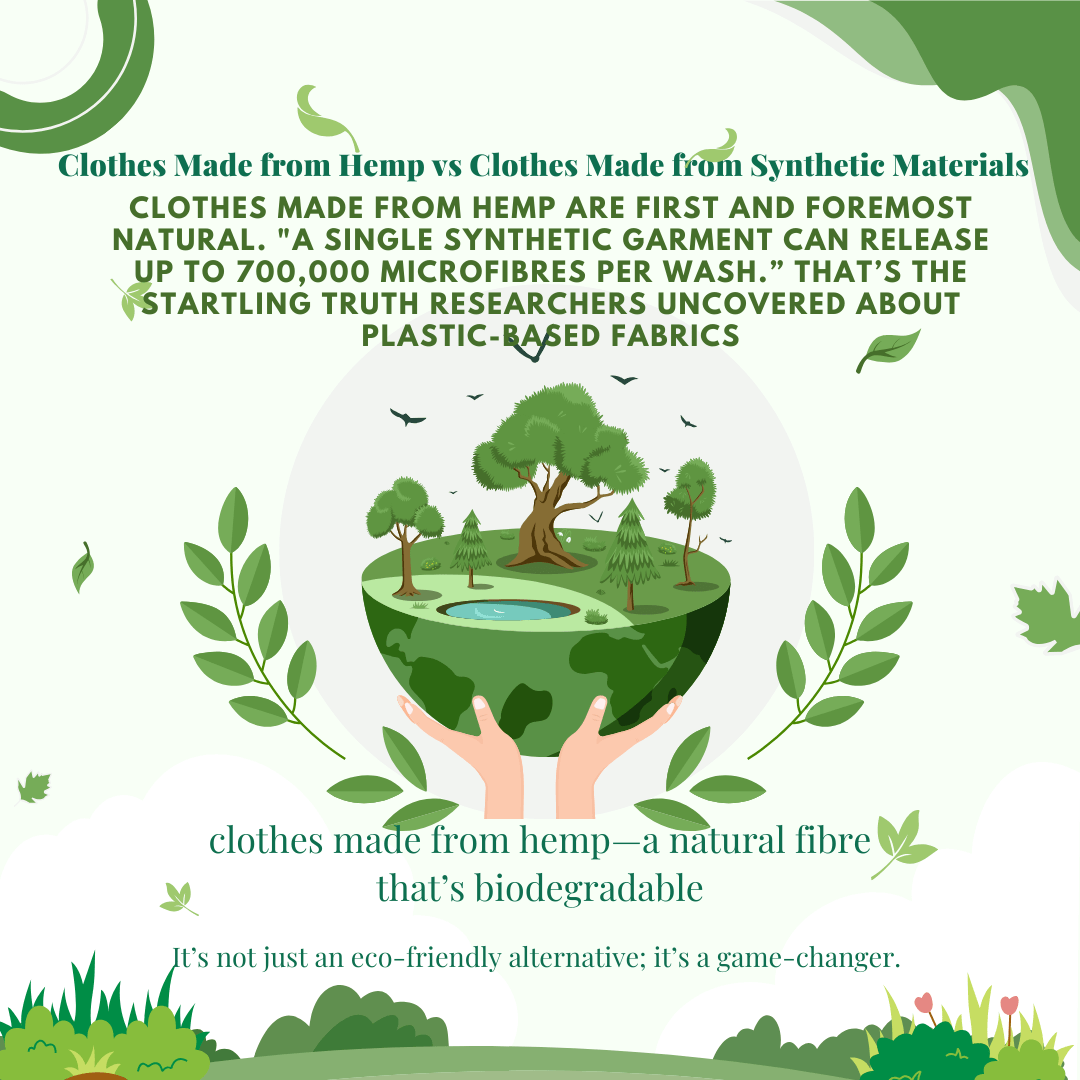Clothes Made from Hemp vs Clothes Made from Synthetic Materials
Clothes made from hemp are first and foremost natural. “A single synthetic garment can release up to 700,000 microfibres per wash.” That’s the startling truth researchers uncovered about plastic-based fabrics. Every cycle in your washing machine sends invisible pollutants into the ocean, harming marine life and, eventually, finding their way back to us.
Now, compare that to clothes made from hemp—a natural fibre that’s biodegradable, breathable, and built to last. It’s not just an eco-friendly alternative; it’s a game-changer. But how does hemp truly stack up against synthetics in durability, comfort, and environmental impact? And more importantly, is it a practical choice for everyday wear?
Let’s break it down.
What Are Clothes Made from Hemp?
Hemp fabric comes from the stalks of the hemp plant (Cannabis sativa). It’s one of the oldest textiles in the world, used for centuries in everything from ship sails to everyday clothing. Why? Because it’s strong, durable, and requires minimal water and pesticides to grow.
Key Benefits of Hemp Clothing:
✔ Eco-friendly – Grows quickly without synthetic fertilisers.
✔ Breathable & Moisture-Wicking – Keeps you cool in summer, warm in winter.
✔ Long-Lasting – Gets softer with every wash but doesn’t fall apart.
✔ Biodegradable – Breaks down naturally, unlike plastic-based fabrics.
Now, let’s put it head-to-head with synthetics.
Clothes Made from Synthetic Materials: The Other Side of Fashion
Synthetic fabrics—like polyester, nylon, and acrylic—are made from petroleum-based chemicals. These materials are designed for performance and affordability, but at what cost? While they offer benefits like stretch and water resistance, they come with major downsides.
Downsides of Synthetic Clothing:
❌ Microplastic Pollution – Every wash sheds tiny plastic fibres into waterways.
❌ Non-Biodegradable – Can take hundreds of years to decompose.
❌ Traps Heat & Sweat – Less breathable, leading to discomfort.
❌ Chemically Processed – Often treated with toxic dyes and finishes.
Now, let’s put hemp and synthetics side by side.
Hemp vs Synthetic Clothing: A Side-by-Side Comparison
| Feature | Hemp Clothing | Synthetic Clothing |
|---|---|---|
| Eco-Friendliness | 100% biodegradable, low-impact | Made from fossil fuels, non-biodegradable |
| Durability | Becomes softer over time, lasts decades | Prone to pilling, breaks down faster |
| Comfort | Breathable, moisture-wicking | Can trap sweat, less breathable |
| Cost | Higher initial cost but lasts longer | Cheaper upfront, but wears out quicker |
| Impact on Skin | Naturally hypoallergenic | Can cause irritation, especially in sensitive skin |
The Hard Facts: Why Hemp Outperforms Synthetics
Hemp isn’t just an eco-friendly option—it’s scientifically proven to be better for both humans and the planet. Here are some powerful facts to consider:
https://www.sciencedirect.com/science/article/pii/S240584402200041X
🌱 Environmental Benefits of Hemp
- Hemp absorbs more CO₂ than trees – It captures carbon from the air while it grows, actively fighting climate change.
- Requires 50% less water than cotton – Unlike thirsty crops, hemp grows efficiently with minimal irrigation.
- No need for pesticides – Synthetics rely on chemical production, while hemp thrives naturally without harmful agricultural chemicals.
- Reduces landfill waste – Since hemp clothing biodegrades in just a few months, it doesn’t sit in landfills for centuries like polyester.
💪 Strength & Durability
- Stronger than steel – Hemp fibres are among the toughest natural materials, meaning hemp clothing can last decades if cared for properly.
- Doesn’t break down like synthetics – Polyester degrades over time, releasing microplastics. Hemp, on the other hand, gets softer but remains intact.
🔥 Comfort & Health
- UV resistant – Hemp naturally protects the skin from harmful UV rays, making it an excellent choice for outdoor wear.
- Hypoallergenic – Unlike synthetics, hemp fabric doesn’t trap allergens or cause irritation, making it ideal for sensitive skin.
- Breathable & moisture-wicking – Hemp clothing naturally regulates temperature, keeping you comfortable in all seasons.
Why Clothes Made from Hemp Are the Future
The fashion industry is shifting. With rising awareness about sustainability, more brands are embracing hemp as a viable alternative to plastic-based fabrics. From everyday wear to high-end fashion, hemp clothing is proving that style and sustainability can go hand in hand.
Choosing hemp over synthetic clothing isn’t just about looking good—it’s about making a conscious decision for the planet and future generations.
So next time you shop, ask yourself: Will this piece last? Will it help or harm the environment? Because in the end, every wardrobe decision shapes the world we live in.
Would you make the switch?
We hope you liked the read and you found it of value. Here are some more articles on the site you may well be interested in.






